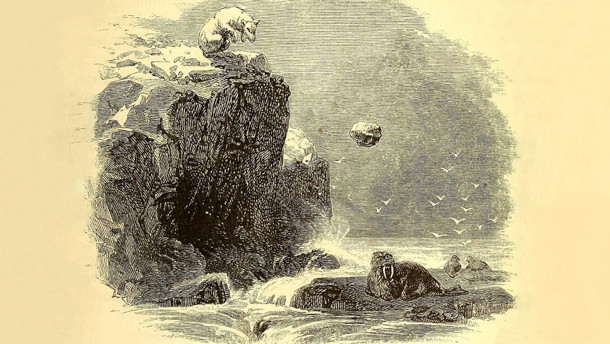Note On Emerging Science: Polar Bears Use Tools to Hunt Walruses
Air Date: Week of August 5, 2022

This illustration, from an 1865 book by adventurer Charles Francis Hall, depicts a polar bear using a rock to kill a walrus. (Photo: Charles Francis Hall, Library of Congress, Public Domain)
With large tusks and weighing over 2,000 pounds, walruses are a formidable foe for Arctic wildlife. But as Living on Earth’s Don Lyman reports, polar bears are utilizing tools such as ice blocks or large stones to hunt walruses as access to other food sources for the bears declines.
Transcript
CURWOOD: Coming up – Bald eagle populations are on the rebound making them easy to spot even in the most unexpected places.
But first this note on emerging science from Don Lyman.
[SCIENCE NOTE THEME]
LYMAN: Weighing over 2,000 pounds, with large tusks and heavy skulls, walruses are a formidable arctic mammal. But research now suggests that polar bears may have found a way to kill the massive pinnipeds. For centuries, Inuit hunters in Greenland and the eastern Canadian Arctic have told stories about polar bears dropping large stones or blocks of ice onto walruses. Explorers and naturalists often dismissed these stories as myths. But the persistence of such stories, along with photos of a polar bear at a Japanese zoo using tools to obtain suspended meat, compelled biologists to investigate. Researchers reviewed historical and recent observations reported by Inuit hunters and non-Inuit researchers. They also looked at documented observations of polar bears and brown bears using tools in captivity to access food. The researchers concluded that “tool use in wild polar bears, though infrequent, does occur in the case of hunting walruses.” Tool use by animals to solve problems is generally regarded as a sign of higher intelligence, but studies on the cognitive abilities of polar bears are lacking. However, scientists say that a great deal of observational information suggests polar bears are very smart. Polar bears feed mainly on seals, which they hunt by looking for the seals’ breathing holes on sea ice. But climate change is melting Arctic Sea ice, so some scientists think that hungry polar bears may increasingly attack walruses for food. That’s this week’s note on emerging science. I’m Don Lyman.
Links
Living on Earth wants to hear from you!
Living on Earth
62 Calef Highway, Suite 212
Lee, NH 03861
Telephone: 617-287-4121
E-mail: comments@loe.org
Newsletter [Click here]
Donate to Living on Earth!
Living on Earth is an independent media program and relies entirely on contributions from listeners and institutions supporting public service. Please donate now to preserve an independent environmental voice.
NewsletterLiving on Earth offers a weekly delivery of the show's rundown to your mailbox. Sign up for our newsletter today!
 Sailors For The Sea: Be the change you want to sea.
Sailors For The Sea: Be the change you want to sea.
 The Grantham Foundation for the Protection of the Environment: Committed to protecting and improving the health of the global environment.
The Grantham Foundation for the Protection of the Environment: Committed to protecting and improving the health of the global environment.
 Contribute to Living on Earth and receive, as our gift to you, an archival print of one of Mark Seth Lender's extraordinary wildlife photographs. Follow the link to see Mark's current collection of photographs.
Contribute to Living on Earth and receive, as our gift to you, an archival print of one of Mark Seth Lender's extraordinary wildlife photographs. Follow the link to see Mark's current collection of photographs.
 Buy a signed copy of Mark Seth Lender's book Smeagull the Seagull & support Living on Earth
Buy a signed copy of Mark Seth Lender's book Smeagull the Seagull & support Living on Earth

